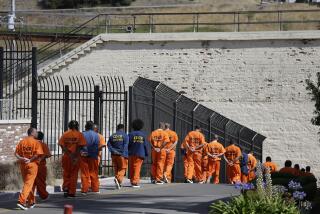Some juvenile killers would get parole if Jerry Brown signs bill
Christian Bracamontes was a 16-year-old on a bicycle the night he and a friend, one gun between them, tried to rob four Riverside teens of their dope.
The friend pulled the trigger, killing 15-year-old Thomas Williams, and pleaded guilty in the 1998 murder. In 15 more years, he can leave prison on parole.
Bracamontes refused to plea bargain and ended up being sentenced to life without possibility of parole.
The disparity goes to the heart of a bill on the desk of Gov. Jerry Brown, one that also pits the freedom of juveniles locked up for life against the grief of families haunted by the loss of their loved ones.
Brown has until the end of the month to choose sides. The bill would allow juvenile killers incarcerated with no possibility of parole to be considered for release after they have spent 25 years in prison. It puts California at the crossroads of a national debate over how to treat kids who kill.
California had 227 juveniles serving life without parole when unsuccessful versions of the bill surfaced in 2007. Now there are 309 such offenders, a mix of killers and accomplices that California judges determined deserved no second chance.
They include a boy who used a table leg to bludgeon his probation officer, the teens who beat a 90-year-old woman to death with her cane and gang members convicted of multiple murders. There also are “model” inmates, such as Elizabeth Lozano.
She was a 16-year-old runaway when her boyfriend shot and killed 13-year-old Tayde Vasquez in Long Beach in 1992. Lozano was convicted of felony murder for her role as an accomplice. Today she is 37, an inmate at California Women’s Facility in Chowchilla, finishing a college degree and mentoring other juvenile offenders.
The punishment of life without parole is “an effective death sentence carried out by the state slowly over a long period of years,” Lozano wrote in a letter distributed last year through prisoner advocacy blogs.
California lawmakers last year fell two votes short of setting aside the state’s sentences of life without parole for all but the most heinous teen offenders.
State Sen. Leland Yee (D-San Francisco), a child psychologist, introduced a scaled-down version of the bill this year, one that could allow Bracamontes to apply for a new, lesser sentence. Teens who kill law enforcement officers or torture their victims are excluded from the measure.
Yee is a firm believer that the teen brain is reckless and prone to disregard risk — which the U.S. Supreme Court has ruled merits special consideration at sentencing.
“We cannot throw away our children,” Yee said in an interview. “Our hearts go out to those families [of victims], but if it turns out there’s a way of salvaging another life, shouldn’t we also look at that?”
The legislation, SB 9, follows a national pattern of increasing protection for juvenile criminals.
In 2005, the Supreme Court abolished the death penalty for minors. In 2010, the high court threw out a Florida law permitting life sentences for teens convicted of such crimes as armed robbery. In July, the Supreme Court struck down mandatory life sentences without parole, used by 28 states, saying judges must have leeway to consider the maturity level and background of children tried as adults.
In California, life sentences without parole are not mandatory but presumed appropriate. Human Rights Watch in 2008 reported that more than 40% of the state’s juvenile lifers were sentenced as accomplices — “someone pretty much everyone agrees has less culpability,” said Elizabeth Calvin, a children’s rights advocate at the organization.
But victims’ survivors say they trust that in every case of a juvenile sentenced to a life term, judges found a reason to reject the option of parole.
“These are the worst of the worst,” said Maggie Elvey, a former San Diego County resident whose husband was bludgeoned during a robbery 19 years ago by boys ages 15 and 16 and died of the injuries.
The youngest of his killers was released from prison after seven years and vanished from Maggie Elvey’s radar. The other, serving life without parole, eventually was convicted of trying to kill another inmate. Elvey attended the trial, taking pleasure in the shock on his face when he saw her there.
“The state gave us a promise, that we would never have to see or hear this person again who killed our loved ones,” said Elvey, who now works in Sacramento as a crime victims’ advocate. “Now liberal-hearted lawmakers are saying, ‘These are just kids.’”
More to Read
Start your day right
Sign up for Essential California for news, features and recommendations from the L.A. Times and beyond in your inbox six days a week.
You may occasionally receive promotional content from the Los Angeles Times.







